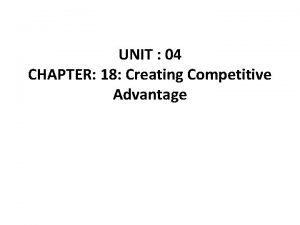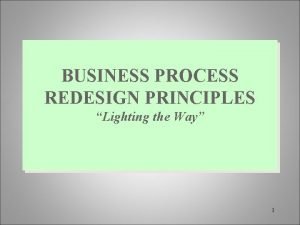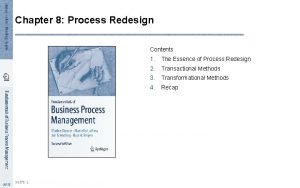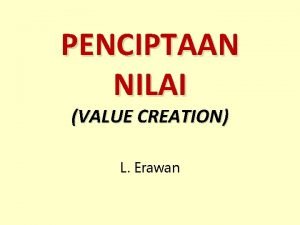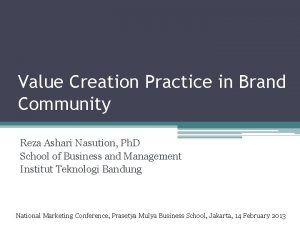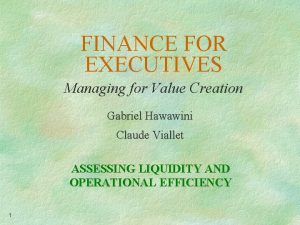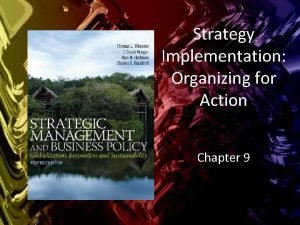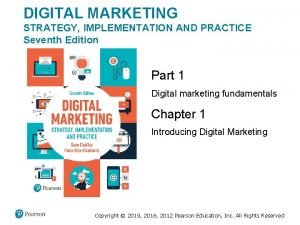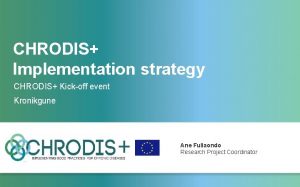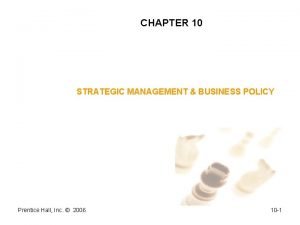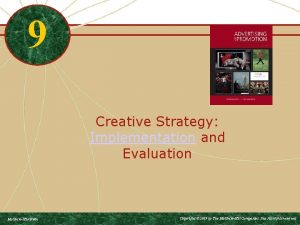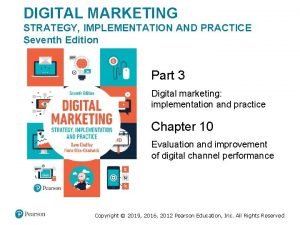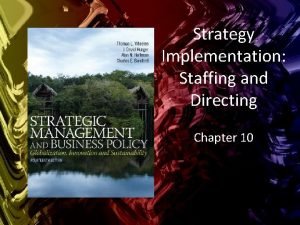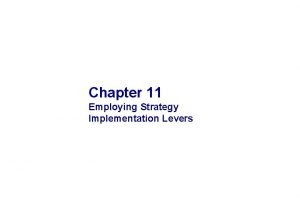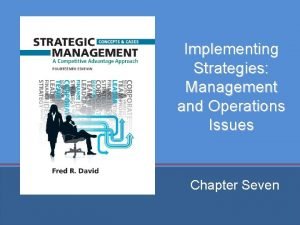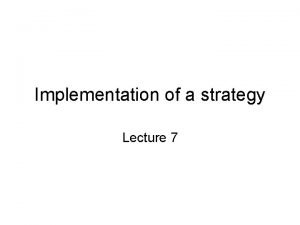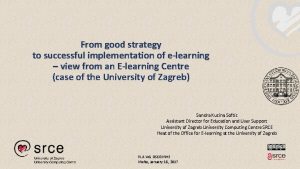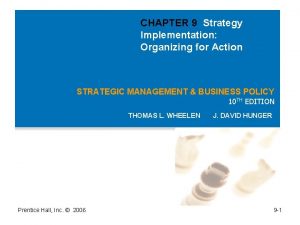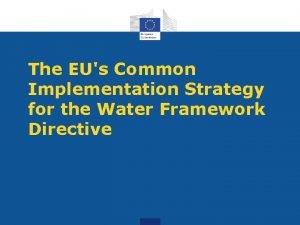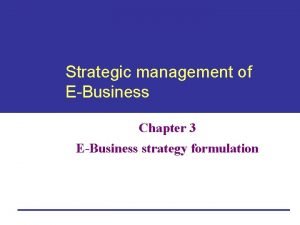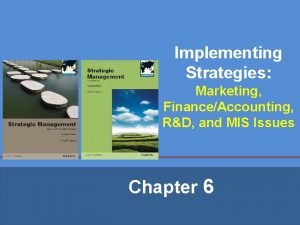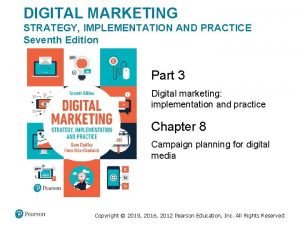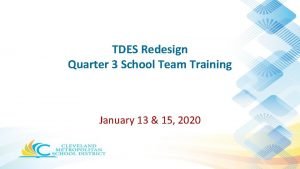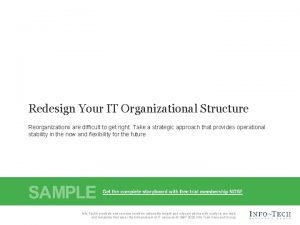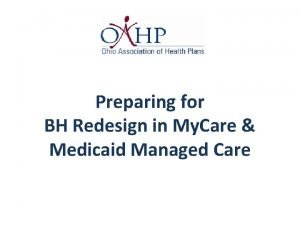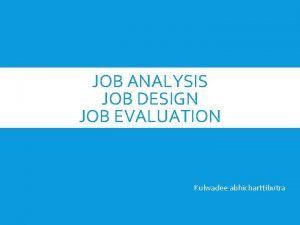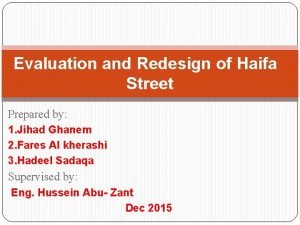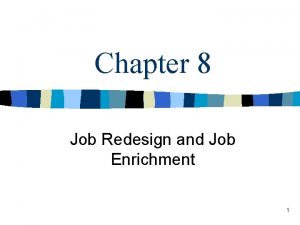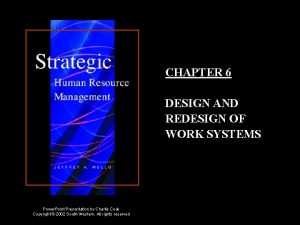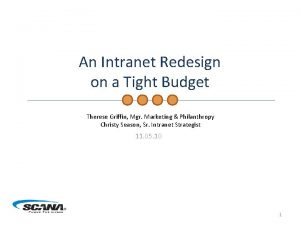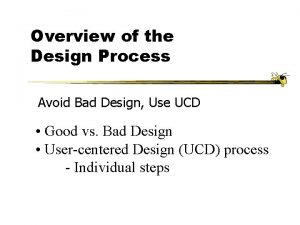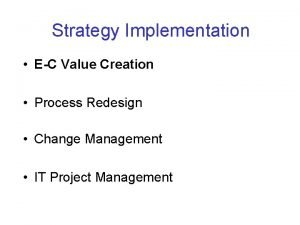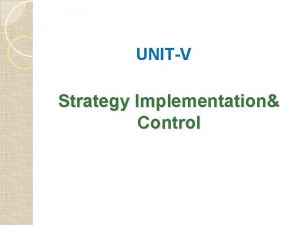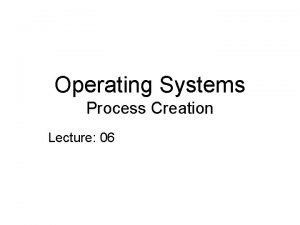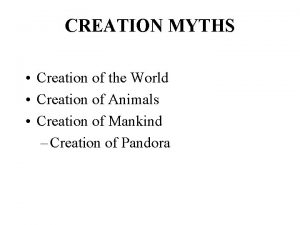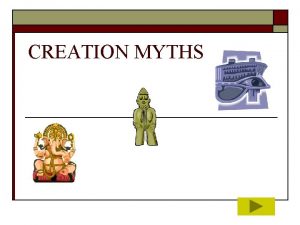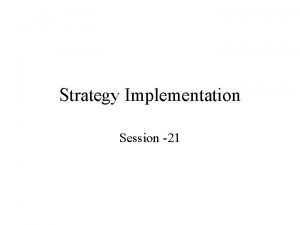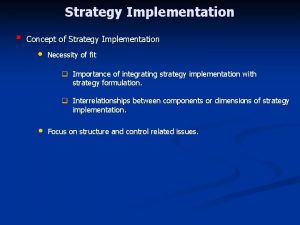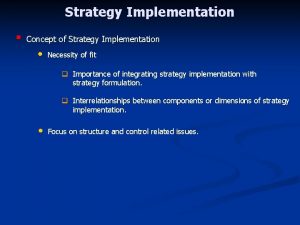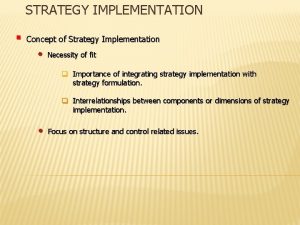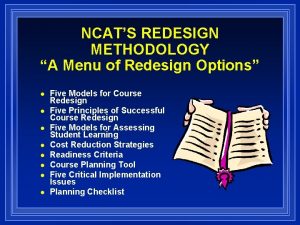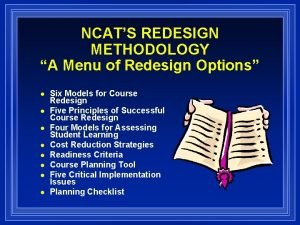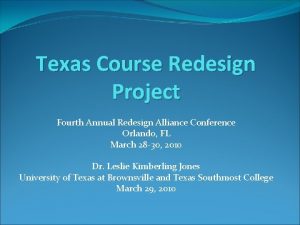Strategy Implementation EC Value Creation Process Redesign Change










































- Slides: 42

Strategy Implementation • E-C Value Creation • Process Redesign • Change Management • IT Project Management

E-C Value Creation: Five Levers • Time (cycle time reduction) • Distance (overcome distance) • Relationships (trust and loyalty) • Interactions (chat, bboard, community) • Product (enhancements, new products)

Value Creation: Time Reduce cycle Quick order entry time Example: Amazon’s 1 -click shopping Extend business hrs. 24 X 7 Service Example: 25% Grainger’s Web sales

Value Creation: Distance Virtual presence Virtual network Example: autobytel. com Location independence Real-time chat Example: AOL’s Instant Messenger

Value Creation: Relationships Alter Role of Intermediaries New intermediaries Example: Free. Markets. com Lock-in User Create switching costs Example: Office. Depot. com

Value Creation: Interactions Get feedback Extensive User Feedback Give control Example: Mc. Graw-Hill (betabooks) User Controls Information Access Example: Otis e*Direct (Plan Your Project. SM)

Value Creation: Product Transactions Help buy/sell used equipment to solutions Example: Milacron Decision support Online Decision Support Tools Example: Turner mania for media managers

Strategy Implementation • E-C Value Creation • Process Redesign • Change Management • IT Project Management

Process Definition Process: A set of activities to produce output for customer/market - Set of inputs + Ordered activities - Cost, time, quality & customer satisfaction - Dynamic view of how value is created Focus: How, not just what Organizational Structure: Cross functional teams

New Product Development Competitor Analysis & Market Research R&D Marketing Manufacturing New Product Development New Product Examples of Cross-Functional Processes Business Functions Proposal Commitment Configuration Credit Sales Manufacturing Delivery Billing Finance Order Management Collection Logistics

Automation vs. Reengineering • Efficiency • • Functional • • Same old rules • • Control • • Low risk, low gain •

Principles of Process Design • Focus on outcomes, not tasks • Do it yourself (Production buys from certified suppliers) • Integrate information processing with real work (Ford) • Treat distributed work as centralized (Global buying) • Link parallel activities while in process, not at the end • Match decision point with work location (empower) • Capture information once, and at the source

Ford Purchasing (1) Purchase Order Vendor Goods (2) Purchase Order Copy (3) Receiving Document Ford Receiving Accounts Payable (500) (4) Invoice (5) Payment Before Ford’s Procurement Process Ford Purchasing Procurement Database After EDI Ford Receiving Accounts Payable (125) Vendor Goods EFT Ford & Vendor Banks

Mortgage Loan Processing at BANC ONE Loan Closing Input Desk-to-Desk Approach: 17 days Laptop Closing Team Approach: 2 days

Role of Information • Process performance monitoring (quality control) • Process integration (information as process glue) • Process customization (mass customization) • Information rich processes (e. g. , financial sector) • Management processes (need external/informal data)

Organizational Enablers Structure: Team Benefits: Wider skill set, Quality of life Criteria: Leadership, Composition, Clarity of goals Empowerment Routines/Culture Participative decision making Lateral communication Incentives, Gain sharing Compensation Career paths: More horizontal, less vertical Work role rotation to create a shared mind set

Why is process re-design difficult? Any major organizational change requires • • •

Strategy Implementation • E-C Value Creation • Process Redesign • Change Management • IT Project Management

What is the new economy? • A loosely defined concept to explain the stock market boom in 90 s and Internet explosion! • Earlier uses have described service economy, globalization, and corporate restructuring. • The IT productivity paradox was finally set aside in late 90 s. • The longest economic expansion ending in Mar ‘ 01 was often attributed to the new economy.

Old vs. New Economy? Industry Context • Low Complexity • Static Industry Context • High Complexity • Dynamic Strategy Formulation • Strategy to fit Industry Strategic Lever • Plan for competition Strategy Formulation • Innovations • Network effects Strategic Lever • Speed Basis for Advantage • Entry & Exit Barriers Basis for Advantage • Organizational flexibility

Change Management – Change is the only certainty in the business world! – Assess the abilities & disabilities of the organization as a whole – The ability of an organization to conceptualize and manage change enables it to compete from the inside out – How can organizations change faster then their environment? – How can mature incumbents effect change?

Organization Life Cycle and Change Challenges Organization Life cycle Entrepreneurial Open/flexible Growth Maturity Change challenges Niche identification (Amazon) Survival shakeout (Dot-coms) Decline Closed/inflexible Restructuring Right work Bureaucracy bashing Employee involvement Improved work Continuous improvement Open/flexible Cultural change Renewal (Whirlpool: Functional to Business units) R e e n e r g i z i n g

A Process for Re-energizing Mature Organizations • Simplicity • Speed • Service Focus on “right” work! 3. EMPLOYEE EMPOWERMENT • Involvement • Job Design • Communication Profit sharing, access to management! 2. BUREAUCRACY “BASHING” • Reports • Meetings • Approvals • Measures Replace low-value work! tom ers Employees no longer feel part of mature organization! 4. CONTINUOUS IMPROVEMENT Cus pp li es (Magnitude of Long-Term Impact) • Mindset • Leadership • Work Su Change/Impact 5. SUSTAINED COMPETITIVE ADVANTAGE 1. RESTRUCTURING • Downsizing • Delayering Be fair yet bold! Time

Incremental Anticipatory Reactive Strategic Tuning Reorientation Adaptation Disruptive Types of Organizational Change Intensity of Change High Low Disruptive Reorientation Adaptation Tuning

What is Disruptive Change? Sustaining Innovations – Improve product in ways customers value Disruptive Innovations – A new market for a new product which is worse, not better, than competing products – Incumbents possess capabilities to foster Sustaining Innovations, and disabilities to embrace Disruptive Innovations

How Can Incumbents Manage Disruptive Change? 1. Creating new capabilities internally: Pull the relevant people out of the existing organization, draw a new boundary around the new group, and create a new process. Examples? 2. Creating new capabilities thru a spinout: If you need a new cost structure or if the opportunity is small, a spinout may work. No need to compete with mainstream organization for resources. Often used by incumbent companies to deal with the Internet. 3. Creating new capabilities thru acquisitions: Easier if capabilities stem from resources only.

Common Change Implementation Problems • Longer than anticipated • Major new problem • •

Strategy Implementation • E-C Value Creation • Process Redesign • Change Management • IT Project Management

Classical Systems Development Life Cycle Investigation: Feasibility (Economic, Technical, Operational) Analysis: Requirements Determination, Logical Design Detailed Design: Technical Design, Coding & Testing, User Training Implementation: File conversion, System Installation

Schematic of Prototyping Identify problem Initial Requirements Convert to Production System If Prototype Inefficient Implement & Use Prototype Develop Prototype Working Prototype Problems Next Version Revise & Enhance New Requirements

Requirements Determination • Information Content, Accuracy, Coverage • System Reliability, Response Time, Transaction Volume, Data Volume • Changes in Input, Output, Processing, Database, Communication

Problems of Requirements Determination • Human Limitations • Variety & Complexity of Requirements • Communication Problem

IT Project Evaluation • Economic Feasibility • Operational Feasibility • Technical Feasibility • Risk Assessment

Economic Feasibility * Development & Operation Costs * Tangible and Intangible Benefits * Cost Benefit Analysis * Payback Period * Return on Investment

Operational Feasibility • Management Support • Quality / Utility / Privacy • User Resistance / Involvement / Training • New People Required • Ease of Use

Technical Feasibility • Technology Required / Acquisition • Schedule Feasibility • Resource / Skills Required • System Availability • Security

Project Risk Assessment • Project Size • Project Structure • Development Group familiarity with IT application • User Group familiarity with IT application

Project Risk Assessment Familiarity with Project Size Technology / Application Low Structure High Large High Risk Medium Risk High Small Medium Risk Low Large Very High Risk Low Small High Risk Medium Risk

Reasons for IT Outsourcing • Its not a core competency or strategic asset • Cheaper to outsource • More flexibility, variable vs. fixed costs • Bandwagon effect

Is it a core competency or a strategic asset? The Decision to Outsource No Likely Outsource, Outsource But Retain In-house If Outsource, Protections? Yes No Does firm have internal expertise?

Yes No Strategic Asset? Protections for Outsourced Assets IP Specified Conditions Company owns, Public System Copyright / patent Vendor builds Private System Non-disclosure clause Company leases Public System Vendor holds copyright Vendor builds/owns Private System Vendor to protect secret Company licenses Vendor builds/owns Protection No. of copies company needs

Examples of IT Activities Outsourced • Development of core applications • Content Provision • Web Hosting • Applications Maintenance • Facilities Management • E-Community Activities • Networking Needs
 Contoh value creation
Contoh value creation Value creation strategy
Value creation strategy Creating and capturing value
Creating and capturing value The plan of action that prescribes resource allocation
The plan of action that prescribes resource allocation Procurement process redesign
Procurement process redesign Process redesign principles
Process redesign principles 1/1 seite
1/1 seite Managerial process of crafting and executing strategy
Managerial process of crafting and executing strategy Pengertian value creation
Pengertian value creation Reza ashari nasution
Reza ashari nasution Finance for executives: managing for value creation
Finance for executives: managing for value creation Governance and value creation ratings
Governance and value creation ratings Structure follows strategy
Structure follows strategy Strategy implementation
Strategy implementation Digital marketing strategy implementation
Digital marketing strategy implementation Implementation strategy example
Implementation strategy example Mis issues in strategy implementation
Mis issues in strategy implementation Implement strategies management issues
Implement strategies management issues Staffing and directing
Staffing and directing Creative strategy implementation and evaluation
Creative strategy implementation and evaluation Digital marketing 7th edition
Digital marketing 7th edition Staffing follows strategy
Staffing follows strategy Levers rewards and rights
Levers rewards and rights Management issues central to strategy implementation
Management issues central to strategy implementation Nature of strategy implementation
Nature of strategy implementation E learning implementation strategy
E learning implementation strategy Strategy implementation organizing for action
Strategy implementation organizing for action Implementing strategies management and operations issues
Implementing strategies management and operations issues Common implementation strategy
Common implementation strategy Implementation strategy
Implementation strategy Mis issues in strategy implementation
Mis issues in strategy implementation Digital marketing strategy implementation and practice
Digital marketing strategy implementation and practice Change management in ehr implementation
Change management in ehr implementation Quarter redesign
Quarter redesign Getting organizational redesign right
Getting organizational redesign right Bh redesign
Bh redesign Difference between job description and job analysis
Difference between job description and job analysis Redesign haifa
Redesign haifa Job redesign meaning
Job redesign meaning Design and redesign of work systems
Design and redesign of work systems Scina
Scina Redesign haifa
Redesign haifa Redesign bad honnef
Redesign bad honnef

